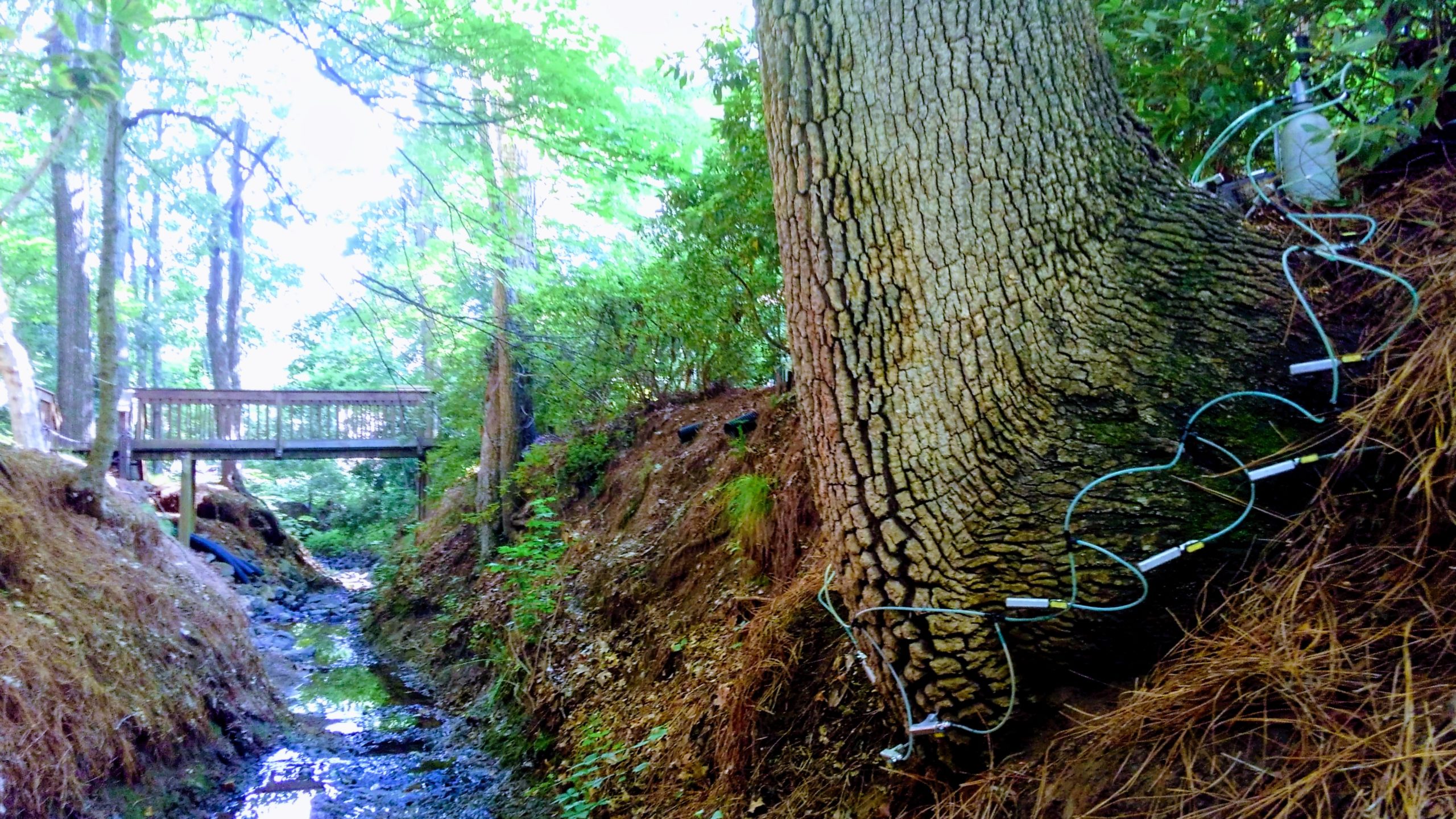CALL TO MEET WITH AN ARBORIST
704.525.3066 Charlotte
828.231.6008 Asheville
704.892.8927 Lake Norman
PLANT HEALTH CARE (PHC)
Plant Health Care (PHC) is a holistic approach to caring for your trees and shrubs with the goal of improving and maintaining the overall health and aesthetics of your landscape. A true PHC program or what we call a Tree Love and Care (TLC) program uses different strategies including cultural, biological, and traditional insect and disease control methods.
Cultural methods are the foundation to a healthy and sustainable landscape. This involves thoughtful selection and placement of new plant stock, proper planting techniques, adequate watering, mulching, soil improvement and pruning to promote health and mitigate tree failure.
Biological control includes the use of natural parasites, pathogens, and predators of pests. Many of these beneficial organisms exist naturally in the landscape and can be promoted by increasing plant material diversity and reducing pesticide usage.
Certain pests and diseases will require treatment, for which we utilize a broad array of natural, organic, and synthetic products. Many of these products are considered to be “bio-rational”, a word to describe products that have low environmental impact. For more information on bio-rational, we recommend these university extension sites: UVM and UMass
TREE LOVE & CARE PROGRAM
This pragmatic approach to landscape management includes seasonally activated scouting for insect, disease, and cultural problems. It can include your whole yard or be tailored to just a small patio or garden. Our focus will be on ornamental trees and shrubs up to 30 feet tall. We use targeted products to treat for specific pests or diseases affecting your landscape. Treatments are based upon the pests/diseases life cycles allowing for treatment when they’re most vulnerable. This enables the use of low volume applications resulting in fewer residuals in your landscape.
PEST & DISEASE TREATMENT
Pest Management
Our trained arborists and professionals are able to identify and help manage a wide variety of insect/arthropod pests that may be harming your plants. We have a host of treatment methods to manage damaging pest populations from the smallest azaleas to the largest oaks trees.
Some of these pests include: Ambrosia beetle, Armored scale, Aphids, Bagworms, Beneficial Insects, Cankerworm, Emerald Ash Borer, Lace Bugs, Oakworm, Soft Scales, Spider mites, tea scale, whiteflies, wood-boring insects.
Crapemyrtle Bark Scale, Redheaded Pine Sawfly
Disease Management
Plant diseases are part of any natural ecosystem, but in your landscape, they can run amok. Proper identification, timing, and treatment methods are all important components to successful disease management. Whether it’s bacteria or fungi, leaf spot or root rot, our arborists use the latest scientifically proven methods to cure your plants.
Typical Plant Diseases include: Anthracnose, Dutch Elm Disease, Leaf Spot, Phytophthora Canker, Powdery Mildew

SOIL CARE
A. Fertilization & Soil Conditioning
Good soil structure and nutrition are cornerstones to tree health. Improving tree health literally starts from the ground up. The trees and shrubs on your property represent a valuable and growing investment to your home and should be properly maintained. Nutrient deficiencies are particularly dangerous for your trees, and can trigger tip dieback, insect attack, and disease. In built environments, property owners tend to remove fallen leaves, the tree’s natural nutrient source. Fertilizing your trees in the Fall and Spring is highly recommended as annual property maintenance. Trees with adequate water and nutrients are less susceptible to attack by pests and disease and can recover more easily if problems arise.
Cambistat, the plant growth regulator (PGR) we use, is scientifically proven to improve the health of trees. Research shows that Cambistat gently slows the growth of trees, allowing the tree to redirect some of its energy from canopy growth to defense chemicals, fibrous root production, and other uses. The resulting benefit of the reallocation of energy will help your tree be healthier and more durable. You should see greener leaves, less insect and disease injury, and your trees will be better able to withstand drought and other environmental stresses.
C. Soil Decompaction
Tree roots have a hard time developing in compacted soil. Loose soil with open pores allows trees to access the oxygen they need and holds water like a sponge. We use a high-powered air tool called an Air Spade to break up compacted soil. This allows us to “till” the soil in a way that is not damaging to structural roots. We then add organic composted material to the soil, which provides nutrients and aids in maintaining proper soil structure. This service is ideal for trees in areas that have been heavily disturbed by construction, vehicles, or heavy foot traffic.
D. Radial Trenching
Radial trenching is used for alleviating soil compaction and adding nutrients to the root zone of trees. It involves air-blasting spoke-like sections of the root zone of the tree, then filling the holes with amendments and organic matter. It is shown to encourage deep root growth far reaching from the trunk and between structural root leaders. This application is especially useful in areas with poor drainage or compacted soils.
E. Vertical Mulching
Vertical mulching is done to decompact and augment soil of a tree’s root zone. Vertical mulching can be particularly helpful when treating declining and construction-impacted trees. This application is especially useful in areas with poor drainage or compacted soils. Vertical mulching involves air-blasting holes in the soil in the root zone of the tree, then filling the holes with amendments and organic matter. It’s used for alleviating soil compaction and adding nutrients to the root zone of the tree. Vertical mulching can increase fibrous root growth and increase air and water penetration into the soil. Trees rely on the soil in which they were planted to provide most of the nutrients required over the course of their entire life. This procedure creates channels for moisture to penetrate the soil.
F. Root Collar
A process in which we remove girdling roots (roots that encircle a tree and suffocate it from receiving and transferring nutrients from leaf to root and back), this slowly will kill a tree and make it vulnerable to all types of issues. Girdling roots are a common problem with improper planting from nursery stock.
TREE BANDING
Those wraps you see all over trees are for canker worms. Canker worms have become less of a problem recently with the shorter winters but they still can present a high risk for the health of our trees. Wrapping the trunk with a “bandage” and a sticky substance catches these canker worms before they make it up into the tree canopy where they damage the health of the tree by eating its foliage. Seems crazy but these little tiny inch worms can hinder the ability for the tree to perform photosynthesis therefore causing its slow death. Tree banding has been an oddly successful solution to the problem of these canker worms. We wrap the trees in the fall and remove the banding in the spring.
EMERALD ASH BORER
A nasty little green beetle that has swept our country almost bare of ash trees. Ash trees are magnificent trees that are also loved by furniture manufacturers and the MLB for baseball bats! Sadly, because of this invasive asian beetle the Ash trees are now an endangered species. Ash trees are commonly found in lowland areas near creeks and wet soils. They can be as small as a dogwood or as big as an oak. Due to it’s invasive and aggressive nature, a trunk injection is the only proven strategy for protection and control. It’s truly a tragedy if we don’t act quick enough to protect the ash trees from the EAB which we can do with an injection treatment that helps the tree defend itself from the beetle.
RISK ASSESSMENTS
Our experts are trained to read the body language of trees. This not only includes tree health but structure as well. We can investigate and report tree structure concerns so you can make educated tree management decisions.
GET LIVE UPDATES FROM HEARTWOOD TREE
Stay current with the updates, newsletter and our event schedule. We are passionate about increasing awareness about the diminishing canopy coverage of our planet and we’re always staying involved to continue to be a part of the solution.

